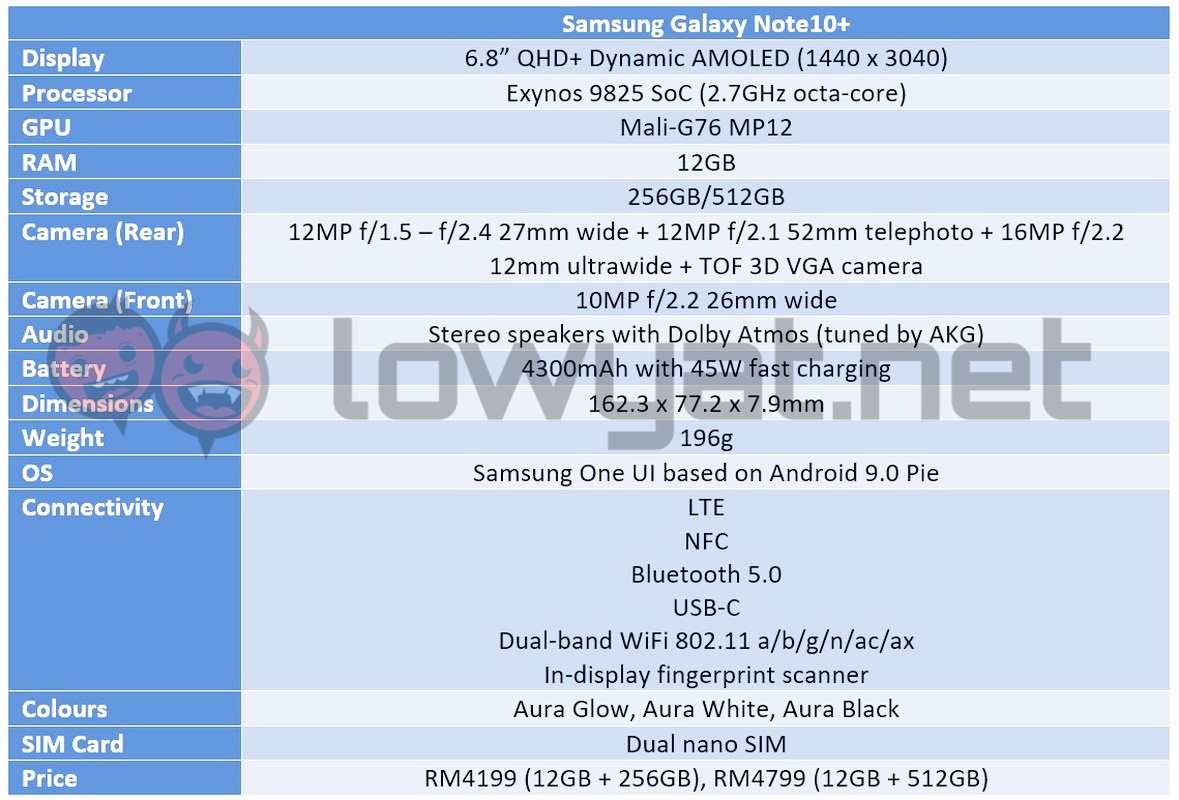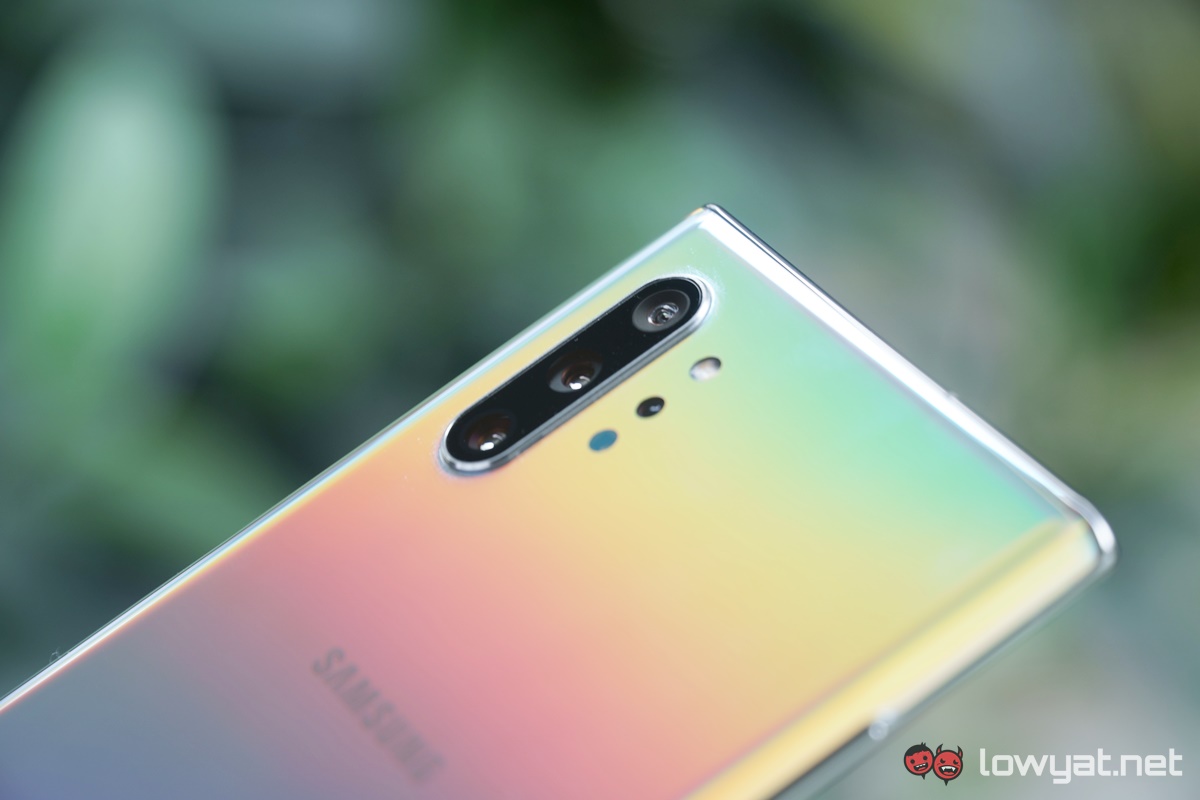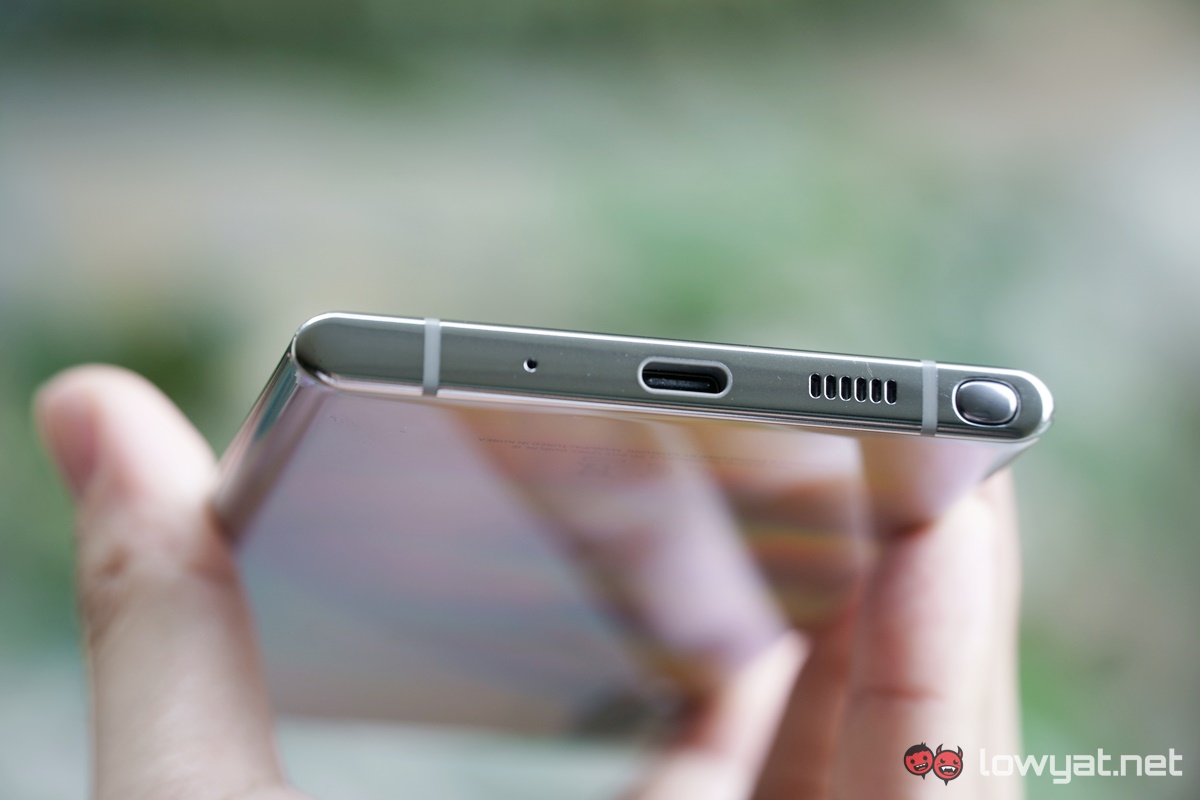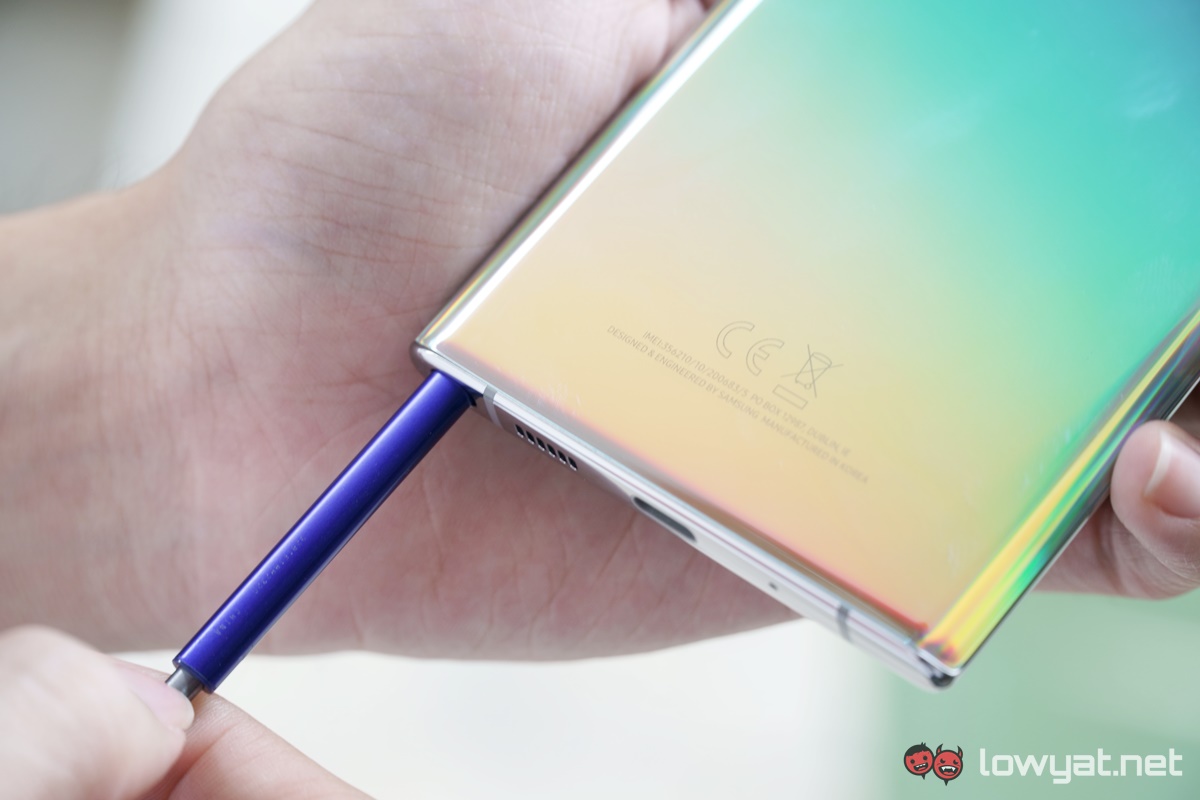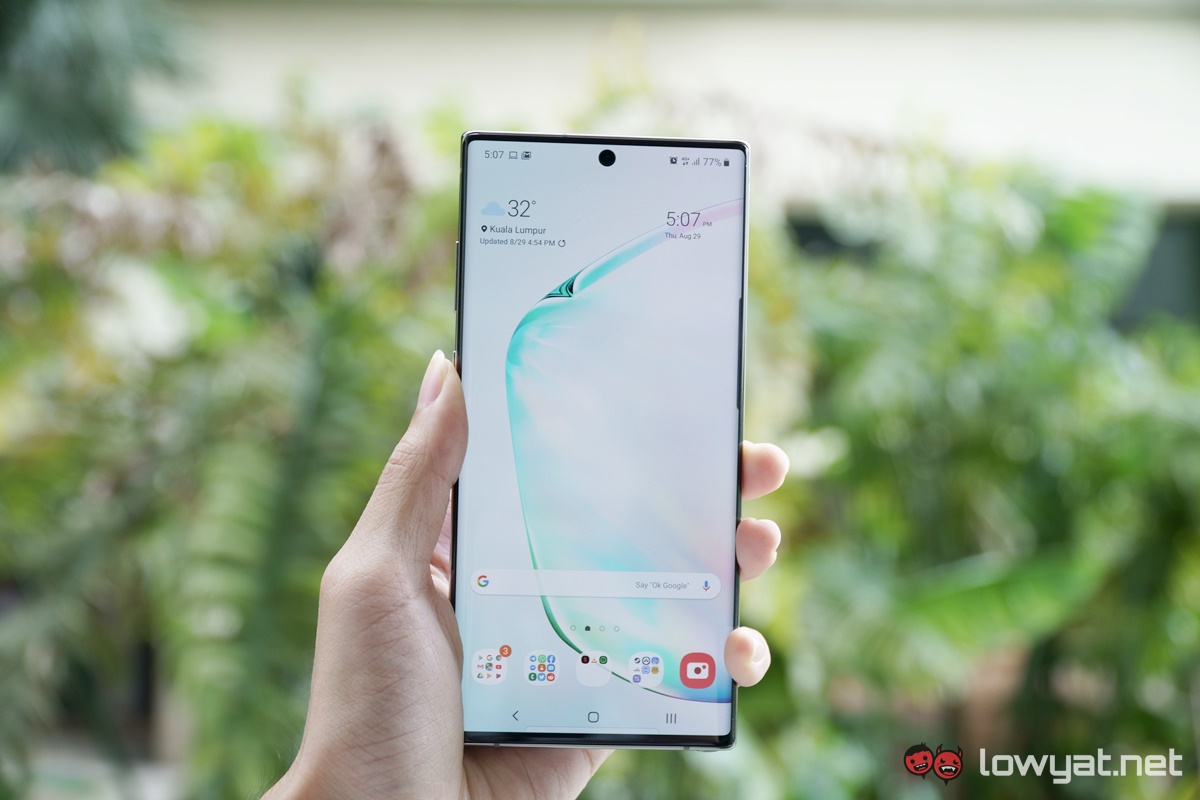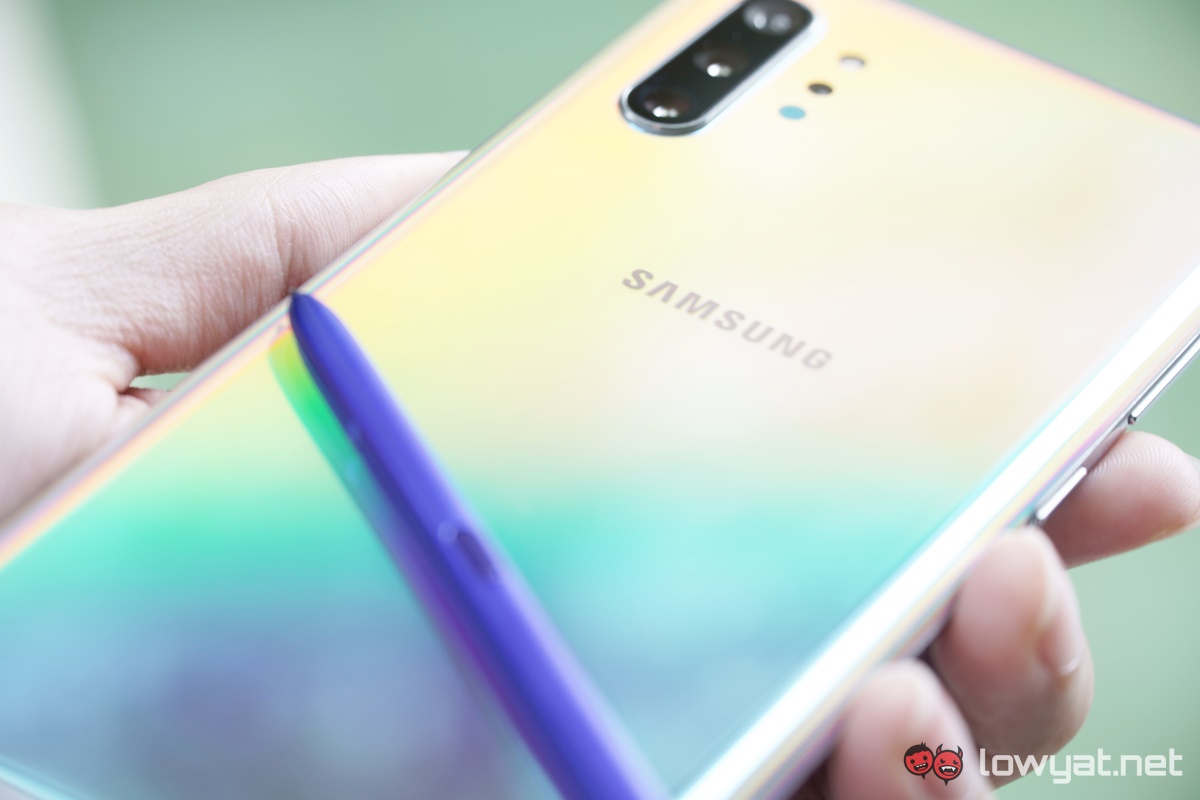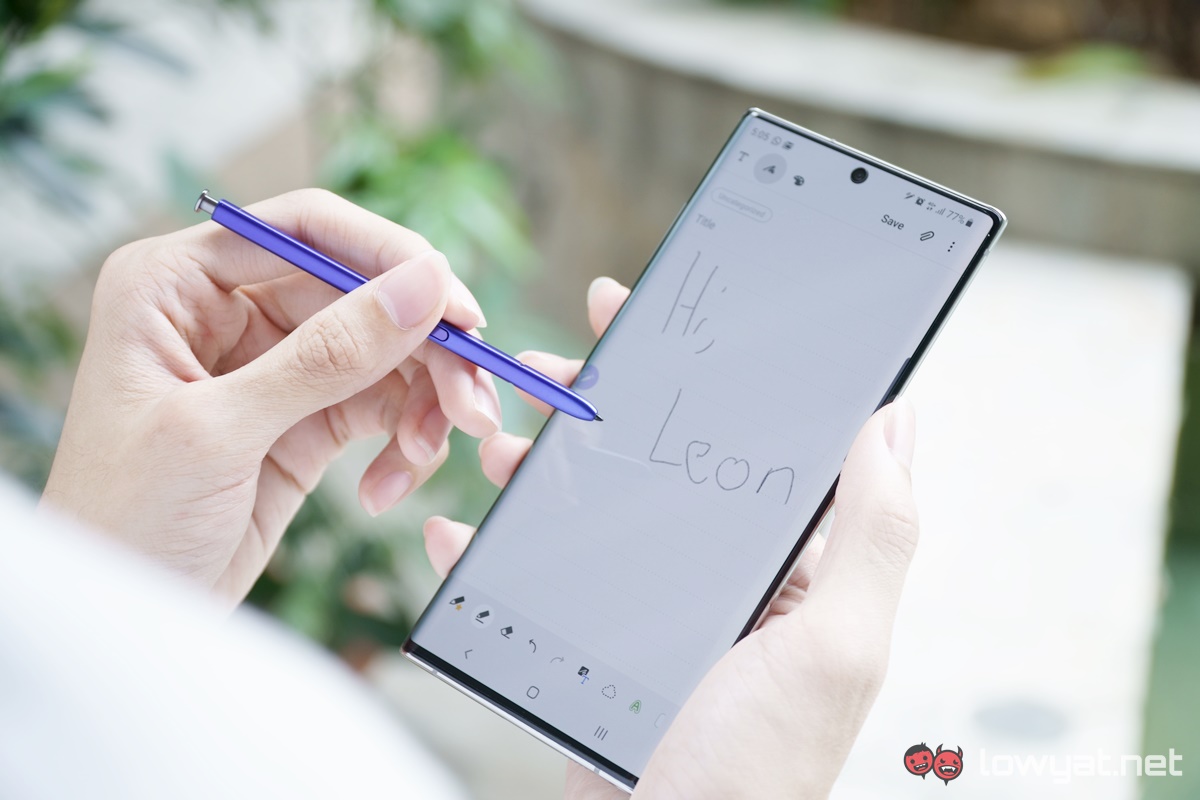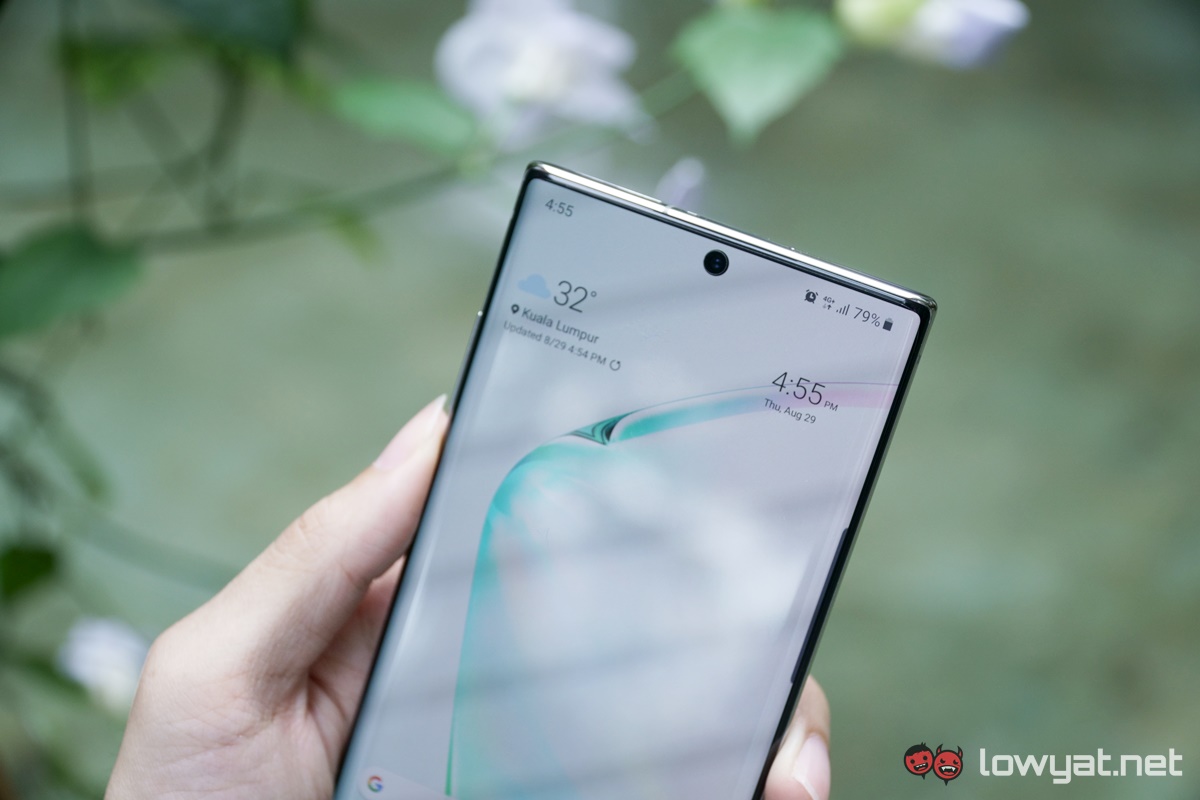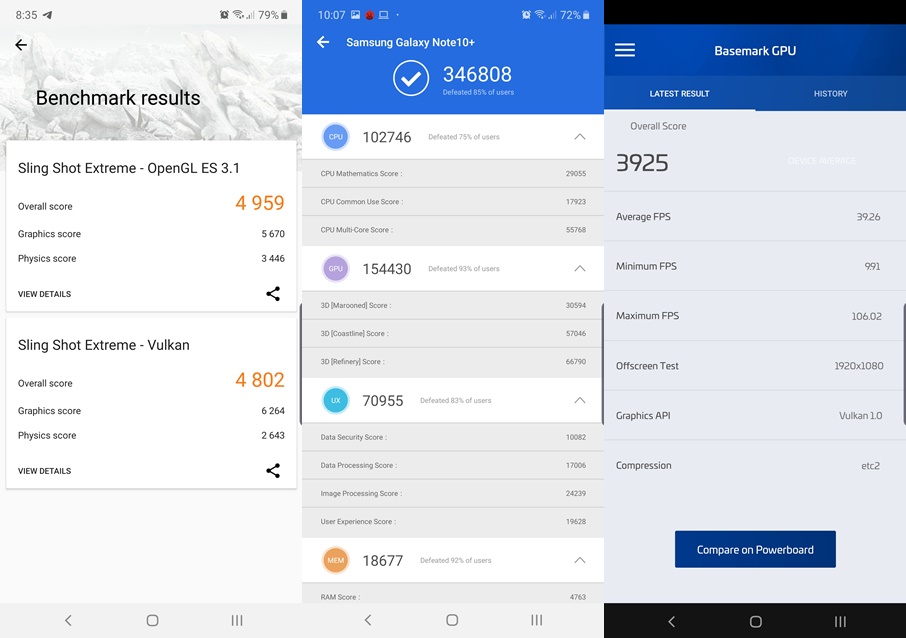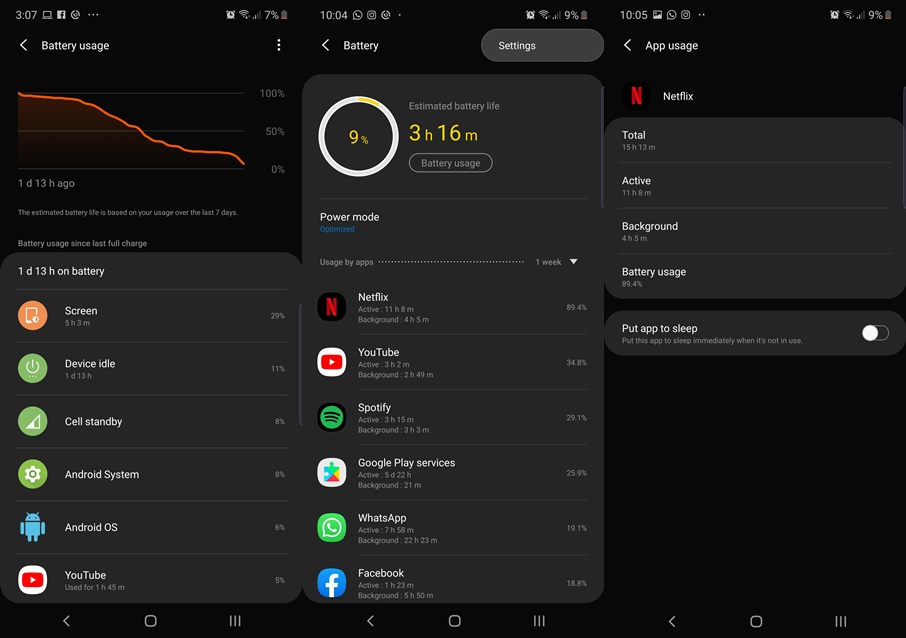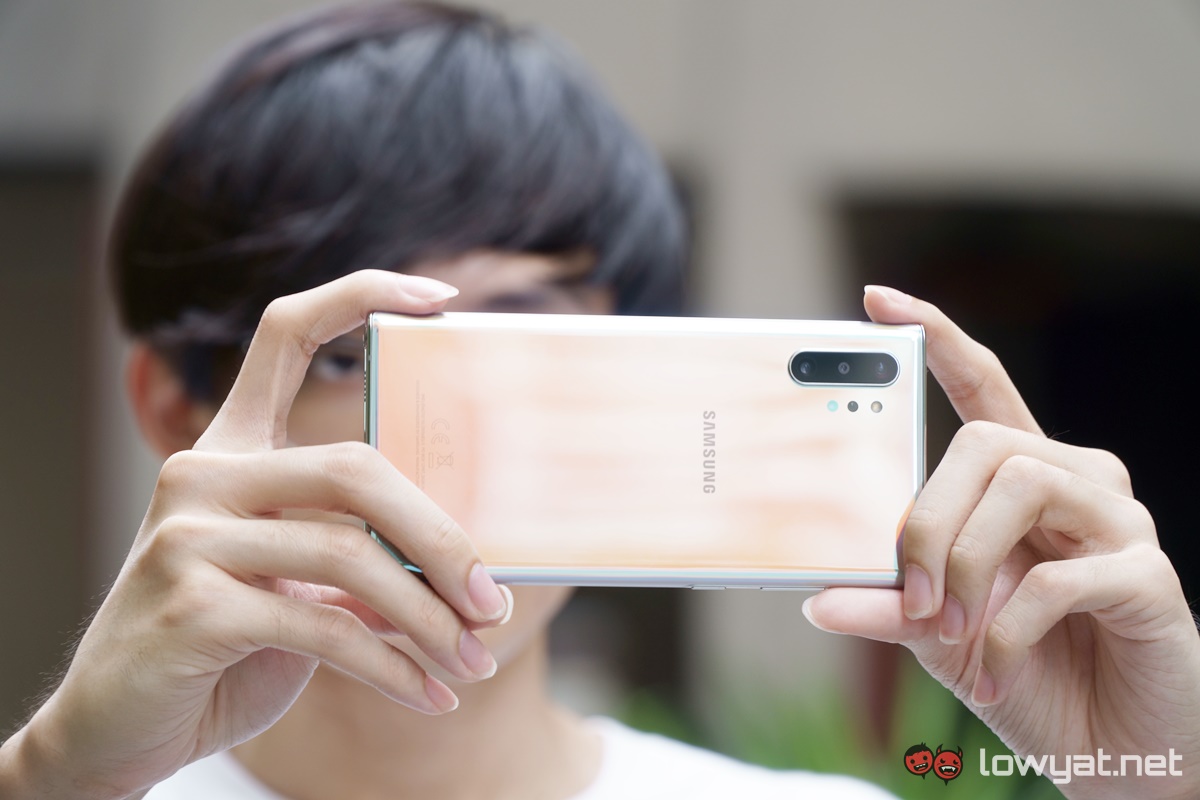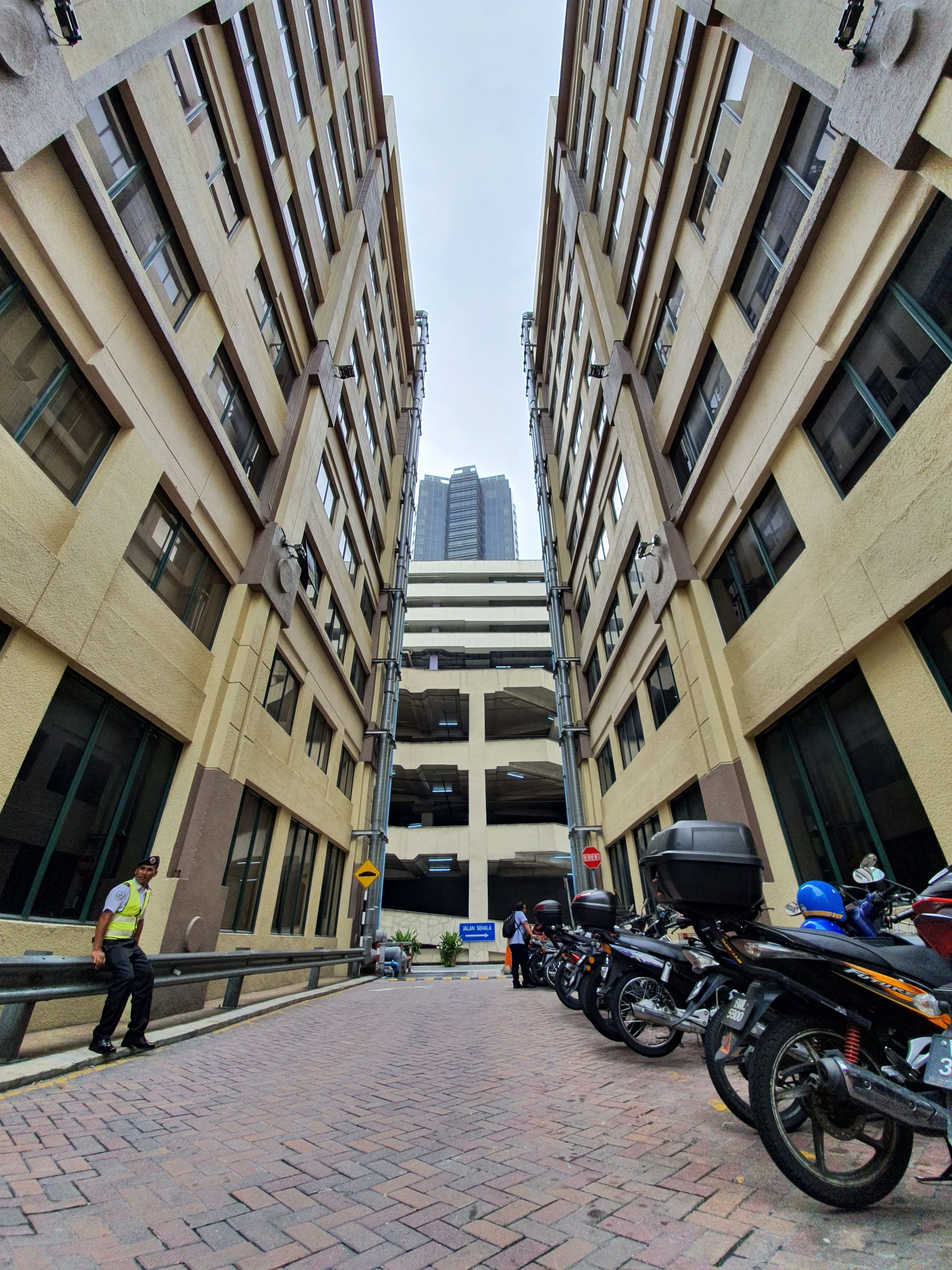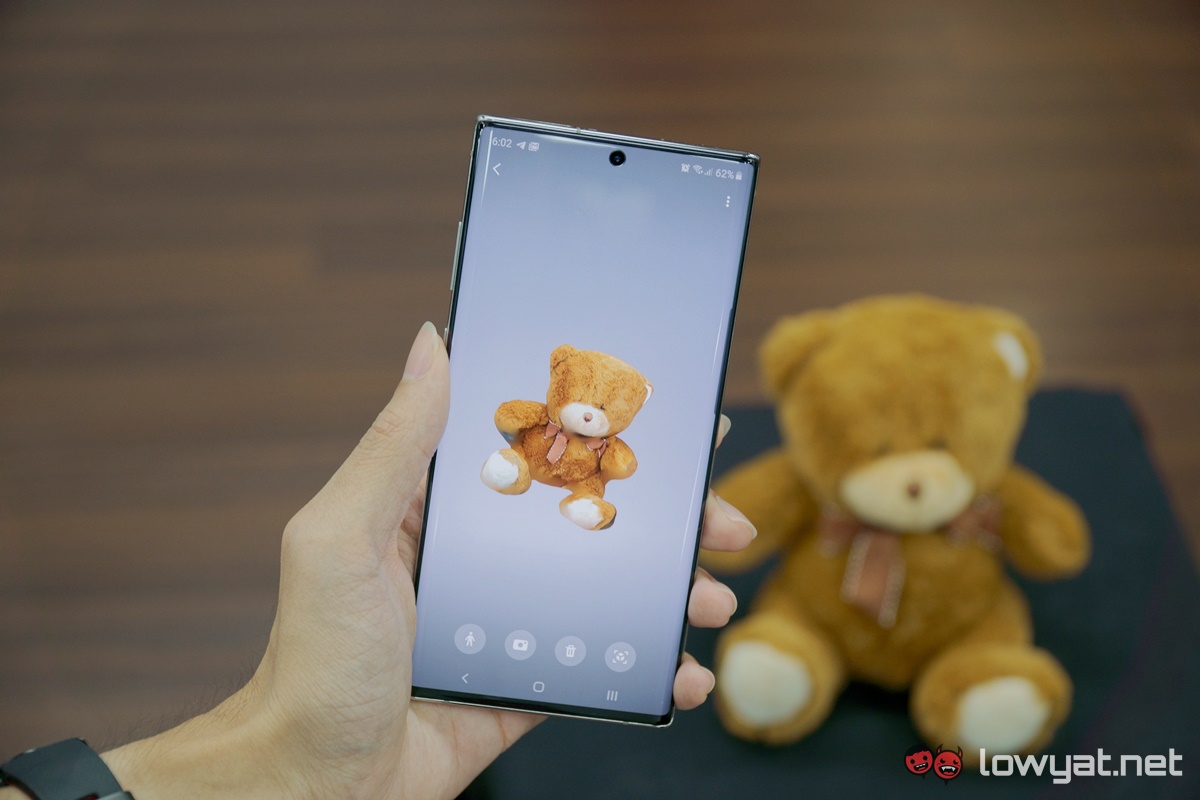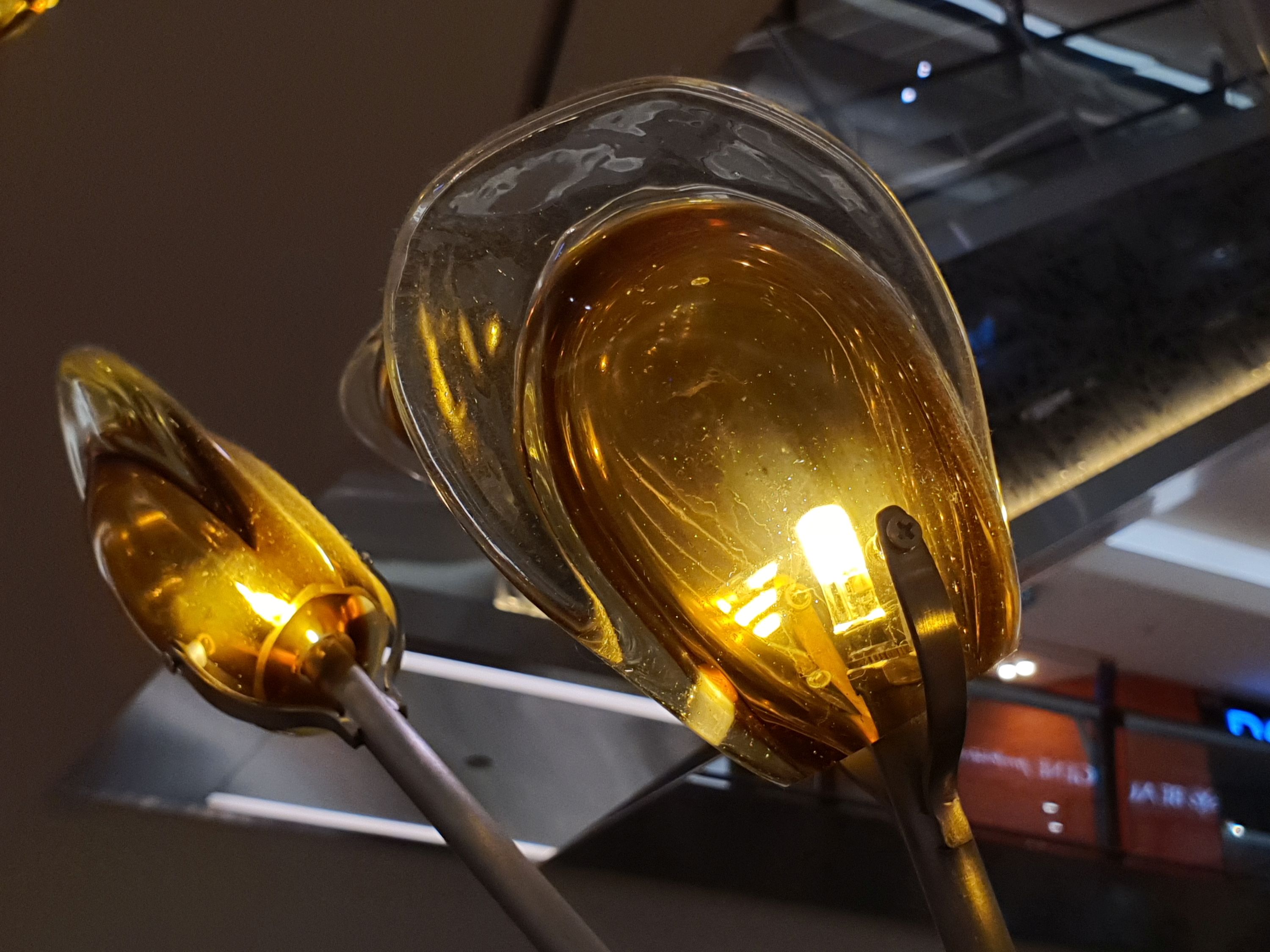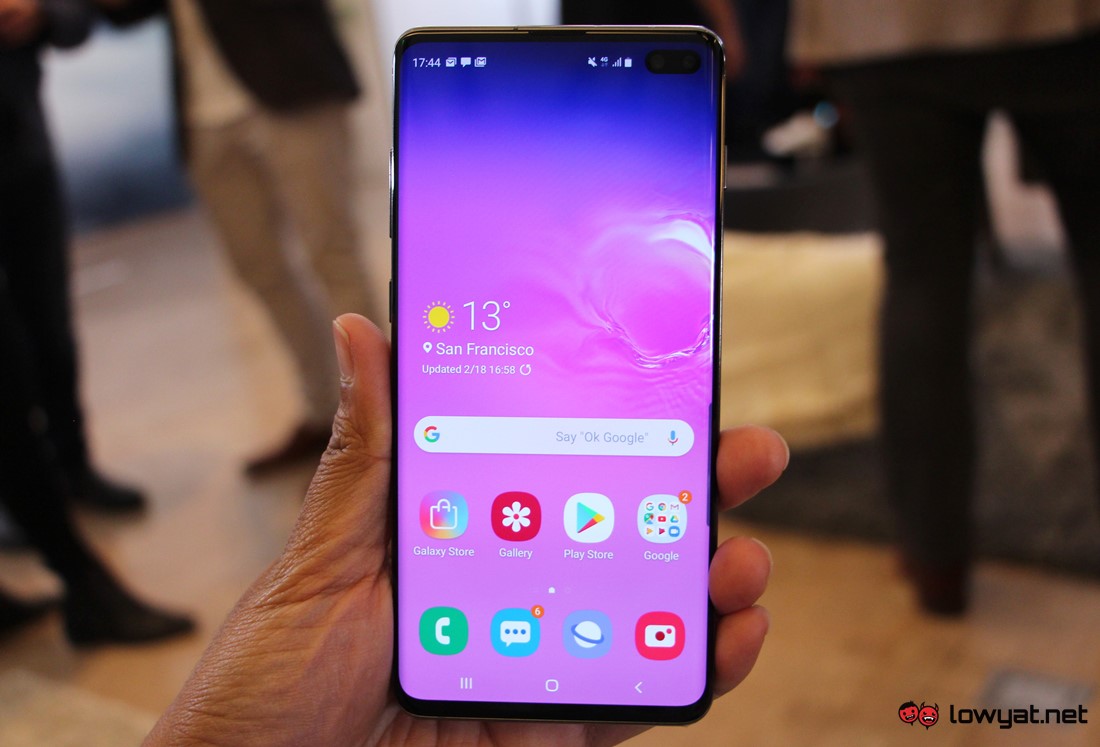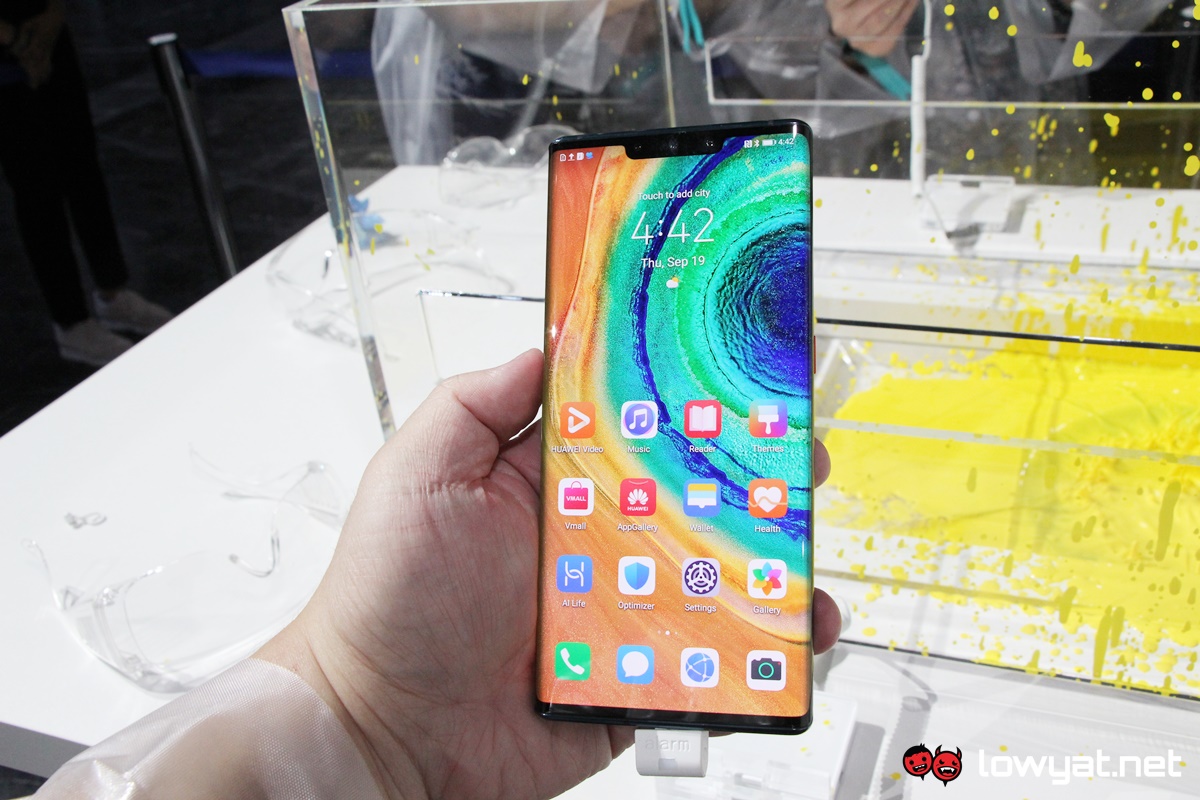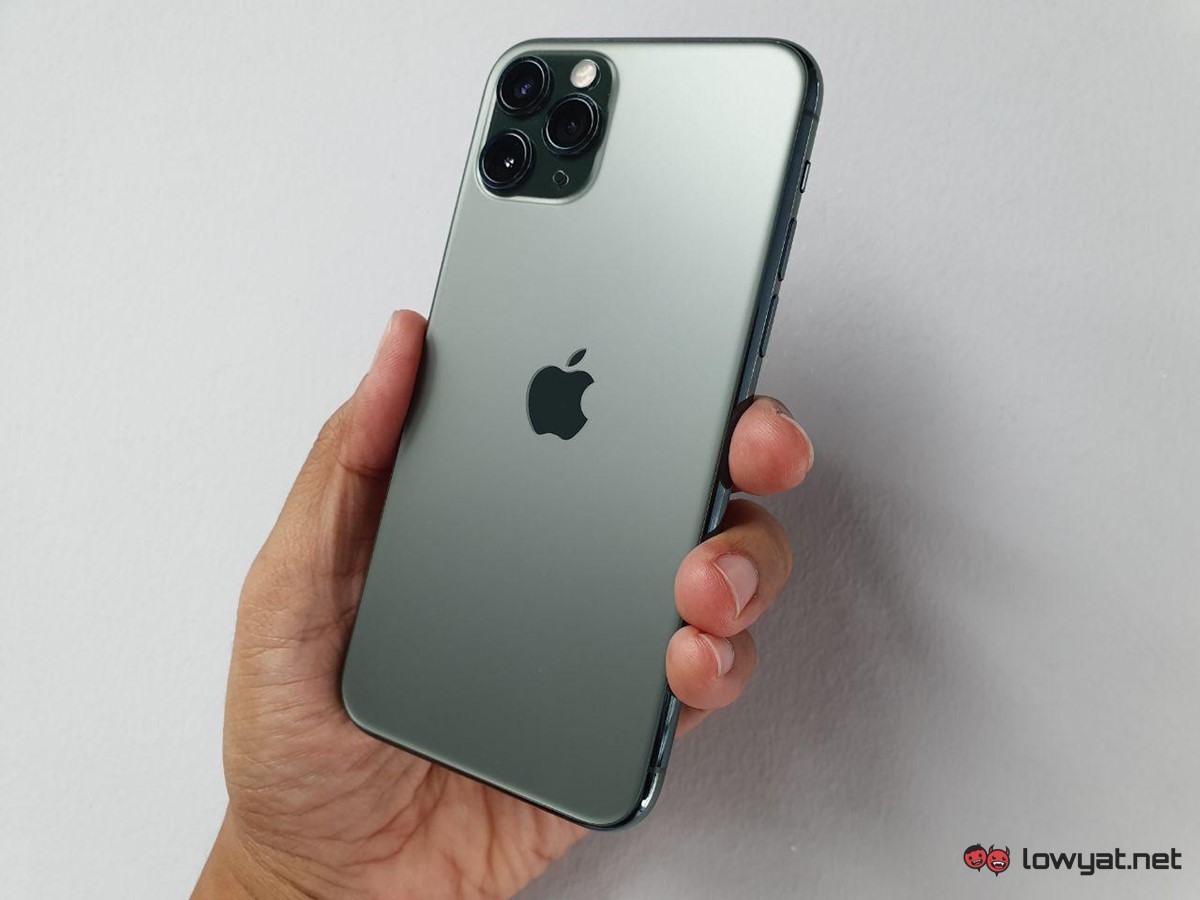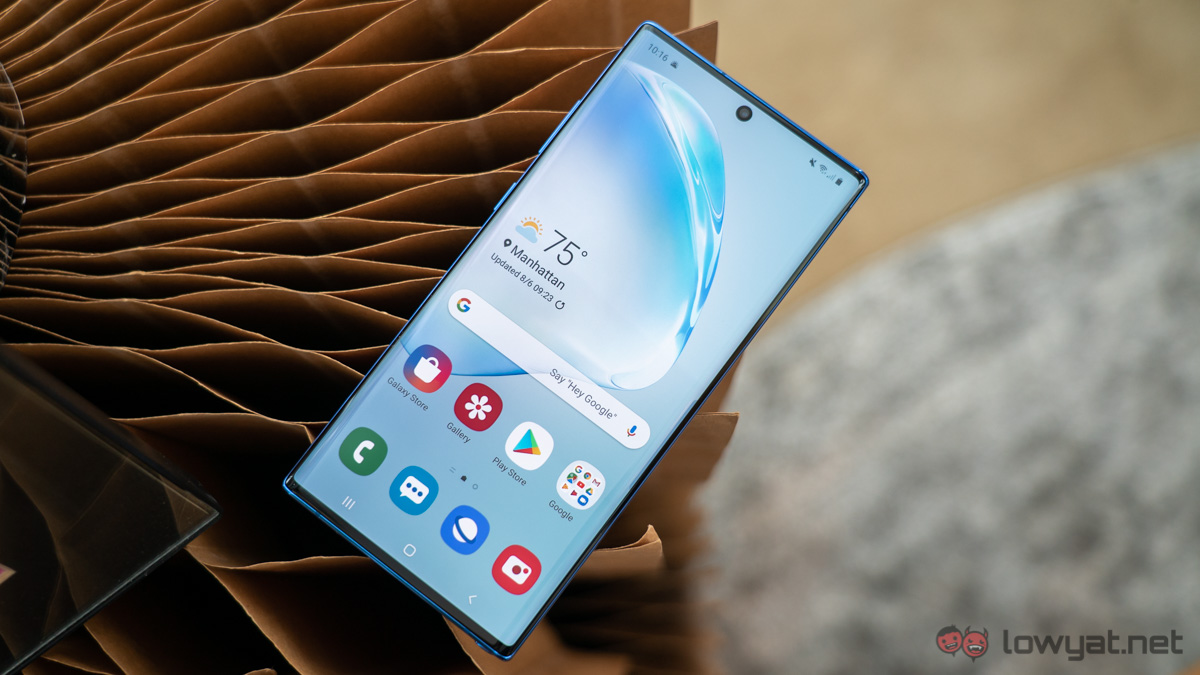I’ve spent some time with the Galaxy Note 10+ to see what makes the phone tick and to address the usual questions, chief among which being: is the phone its starting asking price of RM4199?
Specification
Design
If it isn’t already obvious, the Note10+ features some noticeable, if not obvious differences in its overall design. For a start, it’s AMOLED display still has a punch hole, but rather than slide it to the right or left edge, Samsung has seen fit to place it smack in the middle of the phone’s top bezel. It’s an odd design choice, and a point I will elaborate later in the article.
Of course, I can’t talk about the phone’s large display without a brief mention of the in-display fingerprint scanner. The security feature has been around since Samsung launched its Galaxy S10 and S10+, and works just as well.
The dedicated Bixby button is no more.
Then there’s the new button layout of the Note10+. For whatever reason, Samsung has completely removed all buttons from the right side of the phone and placed both the power button and volume rocker on the left side. The former officially taking the place of the dedicated Bixby button which, on that note, has been removed. Of course, I say removed, but as you can imagine, the button is still able to summon Bixby through some preset options within the operating system. On a related note, the presets are still lacking the option to summon Google Assistant. Moving on, the Note10+ has another milestone under its belt; it’s the first device in the Note lineup that Samsung has chosen to align the main camera module to the side of the phone. Rather than affixing it in the middle, just as the brand has done with past flagship Galaxy devices.
The new S Pen is slightly thinner and improved, but not much else.
On another note, Samsung has also made some slight improvements to the Note10+’s S Pen. It’s a little thinner than the S Pen of its predecessor, the Note9. It’s also slightly thinner, though you wouldn’t be able to tell unless put side by side.
Sadly, the Note10+ ships without a dedicated 3.5mm headphone jack. It’s the first Galaxy device to jump on the 3.5mm-less bandwagon, and a sign that Samsung is starting to fall in line with other smartphone makers. On a related note, Samsung does have a USB-C to 3.5mm adapter for the phone. Unfortunately, the accessory isn’t bundled together with the phone.
User Experience
As you can expect of a flagship device, the Note10+ is fast. Samsung’s One UI is responsive and isn’t cumbersome as most other UIs. Having said that, there are some drawbacks that I take issue with. I still find it odd that the volume function of One UI is still quite rudimentary; rather than giving you ease of access from the side – along with the option to adjust the volume levels of other notifications – the volume slider is small and only appears at the top of the phone, regardless of the phone’s orientation.
The dedicated Bixby button is now gone.
That minor caveat aside, there’s also Bixby which, from my experience, still isn’t quite as intuitive as I would like it to be. On another note, I appreciate Samsung removing the dedicated Bixby button completely; as mentioned earlier, that button has been replaced with a multi-function power button. It’s a smart move, as it means that I never accidentally activate Bixby.
But enough about Bixby, let’s talk about the S Pen. Like its predecessor on the Note 9, the S Pen of the Note10+ can perform a multitude of functions. You can still use the stylus to control the cameras on the phone, control your songs and videos on apps such as Spotify and YouTube, or to view your pictures or slides via gestures. One nifty new feature of the S Pen is its ability to turn on the phone at the touch of the button, literally. It’s a convenient addition to the stylus’s functionality, but not one that I find myself using often.
Still on the S Pen, one feature that really puts the stylus to use is the AR Doodle. The function doesn’t really serve any practical purpose but using the S Pen to draw shapes on the display while moving around is quite fun.
The punch hole in the middle seems misplaced.
Then there’s the Note10+’s Dynamic AMOLED display, which is just gorgeous to look at. Colours on-screen seem to pop, blacks are deep, and the whites are bright. However, if you’ve never used a smartphone with an edge-to-edge display, using this phone does take some getting used to. On more than one occasion, I would find the palm of my hands accidentally starting up the camera app or the display’s settings options.
One issue I have with the display is the position of the punch hole. With the Galaxy S10 series, having the punch holes at the side makes sense; placing the camera in the middle of the Note10+ feels awkward and isolated. Of course, you can hide it via the phone’s software, but it still doesn’t detract from the fact that Samsung simply could have left it sitting on the side. Another sticking point of mine is the display refresh rate of the Note10+. Considering the number of competitor smartphones that already utilise display with refresh rates as high as 120Hz, I think it’s a missed opportunity for Samsung to finally jump on that bandwagon.
In terms of performance, the Exynos 9825 underneath the hood is a beast. The synthetic benchmarks notwithstanding, the Note10+ has no issue handling the most memory or CPU intensive apps. While I rarely game on the phone, playing the occasional shooter or RPG titles such as Fortnite and Final Fantasy Tactics. shows no signs of lagging or stuttering.
That long-lasting battery and much improved charging rate.
Perhaps the greatest improvement to the Note10+ is its battery life. On a full charge, the 4300mAh gives me nearly two days of use, and that’s just from using my phone as a daily driver. Where the battery life really shines is when I start binge-watching movies and videos on Netflix and YouTube. With the former, the phone gave me a little more than 11 hours of constant streaming.
In addition to a longer lasting battery, Samsung has also improved the charging rate of the Note10+ with a new 45W 25W (it appears that the 45W charger doesn’t come bundled with the phone and is a separate purchase) fast charger in the box. Once plugged in, 30 minutes of charging give me 60% battery life; it’s an improvement over the Note 9, which only gave 37% battery for the same amount of time. On another note, I think the stereo speakers of the Note10+ are worth a mention too. They’re loud and clear, and even in areas with an open-air setup, I have no issues watching videos while listening in to any and all media content.
Camera
Like its Galaxy S10 and S10+ counterparts, the Note10+ features the same triple-camera main array, comprising 12MP wide + 12MP telephoto, and 16MP ultrawide sensors with the dual aperture mode. That means the same super-fast autofocus and extremely responsive camera app that takes beautiful and fuss-free shots.
Still a very solid camera system.
Daytime photography with the Note10+ is, unsurprisingly, an absolute dream. Shot taken are sharp, clear, and retain an incredible amount of detail. In addition to a tried and trusted camera system, it also comes with several of the same camera features, such as Scene Optimiser and Live Focus. The former allowing the Note10+ camera to adjust and enhance a scene to one of several pre-set settings.
Low-light camera performance is just as impressive, and in most of the shots I take, the end results still retain a lot of detail, have low noise, and adequate lighting. To be fair, there are some moments when my night shots suffer from overexposure, but that’s only because the area in question is severely lacking light. Photography notwithstanding, the Note10+’s 3D TOF sensor also let me make sure of Samsung’s 3D Scanner app, which is downloadable via the brand’s own app store. It reminds me of Sony’s 3D Creator app, but rather than just taking a 3D capture of your face, Samsung’s version of the app can capture a 3D model of an entire subject.
Mind you, it’s not perfect, and to do a full 3D scan, your subject needs to be positioned behind a dark background. Also, the final render isn’t always accurate, and the subject often looks mangled.
Sample Images
Competition
Pricing is always a major determining factor whenever high-end smartphones are up for consideration. The starting price of RM4199 for the Note10+ is undoubtedly steep, but if you’re willing to splurge that sort of money, and you’re not concerned about having a dedicated stylus, there are a slew of options.
Samsung Galaxy S10+
If the S Pen is not crucial to you and you still want a flagship Samsung Galaxy device, there’s always the Galaxy S10+. Specs-wise, the phone is powered by the slightly less beefy Exynos 9820 SoC, 8GB of RAM instead of 12GB, and a maximum expandable storage option of just 128GB. On the upside, the phone sports the same triple-camera main array and the Note10+, making it an equally capable shooter as its newer brother. On the plus side, the display of the S10+ is also very sizable at 6.4-inches, although the dual punch hole at the top right may be a put off to some users. Also, at an asking price of RM3699, it’s significantly cheaper than the Note10+.
Huawei Mate 30 Pro
The Huawei Mate 30 Pro was recently launched, but it doesn’t change the fact that it is still flagship contender. Like the Note10+, there’s a lot to shout about this phone; it runs on the Huawei’s newest Kirin 990 SoC, comes with 8GB RAM, and has an internal storage configuration of 256GB. The Mate 30 Pro’s new Horizon Display is also appealing, especially if you’re a fan of the phone’s new Side-Touch functionality. Of course, the star attraction of the phone is its quad-camera main array, which has a near identical zoom functionality as the P30 Pro, and the ability to record ultra slow-motion video at a whopping 7680 fps. The one major deciding factor is, of course, the software of the Mate 30 Pro; due to the on-going trade war between the US and China, the phone will lack access to the Google’s Media Services, and instead runs on Huawei Media Services.
iPhone 11 Pro Max
On the opposite end of the spectrum, the iPhone 11 Pro Max is a direct contender to the Note10+. The phone features a 6.5-inch Super Retina XDR Display, 4GB RAM, and like the Note10+, it comes with up to 512GB of internal storage. Another major difference between the two is the chipset: the iPhone 11 Pro Max uses Apple’s new and proprietary A13 Bionic SoC. Of course, the phone also runs on the latest Apple iOS 13. More importantly, the phone also sports a triple 12MP main camera system round the back. The only drawback I can think of is the price: it starts from RM5299 for the model with 64GB, while the top-of-the-line variant with 512GB will set you back a whopping RM6899.
Conclusion
Once again, just as we had said about the Galaxy Note 9, the Samsung Galaxy Note10+ is undoubtedly Samsung’s most refined, most impressive, and most daring smartphone to date. The phone breaks away from the current design norm with the new position of its power button, volume rocker, and punch hole camera on the display.
Samsung’s best and most expensive Galaxy Note smartphone, to date.
At a starting price of RM4199 and RM4799 for the top-tier variant, it’s also one of Samsung’s most expensive flagship smartphone to date. Look beyond the price, though, and the Note10+ is a flagship phone with impressive battery life, a brilliant camera, massive storage and lightning-fast performance. At least, until the next Galaxy Note flagship comes along the next year. Photography by Ming Hoo and Li Jin Soh.
